Meet Dragon V2 – SpaceX CEO Elon pulls the curtain off manned Dragon V2 on May 29, 2014 for worldwide unveiling of SpaceX’s new astronaut transporter for NASA. Credit: SpaceX
Story updated[/caption]
SpaceX CEO and billionaire founder Elon Musk gushed with excitement as he counted down the seconds and literally pulled the curtain away to unveil his company’s new manned Dragon V2 astronaut transporter for all the world to see during a live streaming webcast shortly after 10 p.m. EST (7 p.m. PST, 0200 GMT) this evening, Thursday, May 29, from SpaceX HQ.
The first photos from the event are collected herein. And I’ll be adding more and updating this story as they flow in.
Musk’s Dragon V2 unveiling was brimming with excitement like a blockbuster Hollywood Science Fiction movie premiere – with lights, cameras and action.
But this was the real deal and hopefully gets America moving again back to thrilling, real space adventures in orbit and beyond – reaching for the stars.
“The Dragon V2 is a 21st century spacecraft,” Musk announced to a wildly cheering crowd. “As it should be.”
“We wanted to take a big step in spacecraft technology. It is a big leap forward in technology and takes things to the next level.”
“An important characteristic of that is its ability to land anywhere on land, propulsively. It can land anywhere on Earth with the accuracy of a helicopter.”
“I think that’s what a spaceship should be able to do.”
“It will be capable of carrying seven astronauts. And it will be fully reusable.”
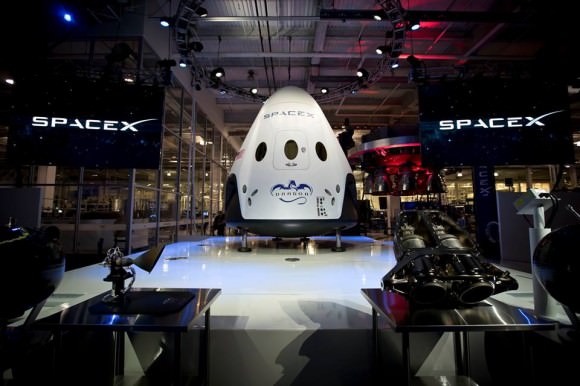
The sleek gleaming spaceship looks decidedly different from the current cargo Dragon V1.
Read my “Dragon V2” preview articles leading up to the May 29 event – here and here.
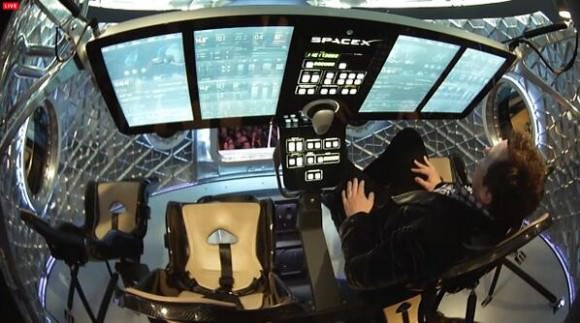
This new manrated Dragon is aimed at restoring US human launch access to space from American soil by carrying crews of up to seven US astronauts to low Earth orbit and eventually perhaps Mars – starting as soon as 2017.
Musk unveiled the gumdrop-shaped Dragon V2, or Version 2, to an overflow crowd of employees and media at SpaceX headquarters and design and manufacturing facility in Hawthorne, CA.
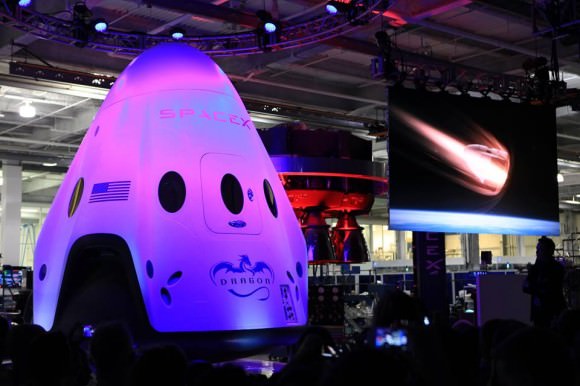
But Musk and SpaceX are not alone in striving to get Americans back to space.
Two other US aerospace firms – Boeing and Sierra Nevada – are competing with SpaceX to build the next generation spaceship to ferry astronauts to and from the ISS by 2017 using seed money from NASA’s Commercial Crew Program in a public/private partnership.
Altogether they have received more than $1 Billion in NASA funding.
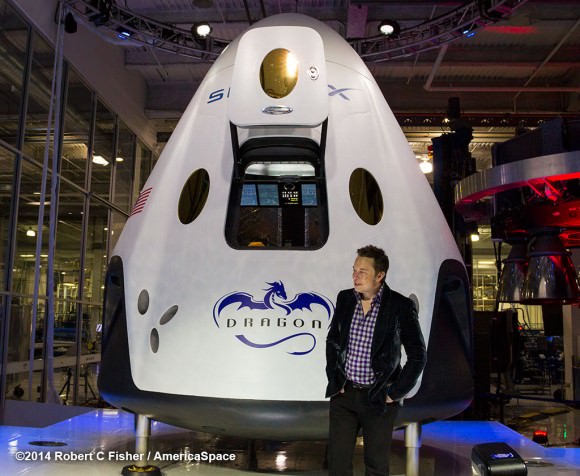
The Boeing CST-100 and Sierra Nevada Dream Chaser ‘space taxis’ are also vying for funding in the next round of contracts to be awarded by NASA around late summer 2014.
The ‘Dragon V2’ is an upgraded, man-rated version of the unmanned Dragon cargo spaceship that just completed its third operational resupply mission to the ISS with a successful splashdown in the Pacific Ocean on May 18.
Stay tuned here for Ken’s continuing SpaceX, Boeing, Sierra Nevada, Orbital Sciences, commercial space, Orion, Mars rover, MAVEN, MOM and more planetary and human spaceflight news.
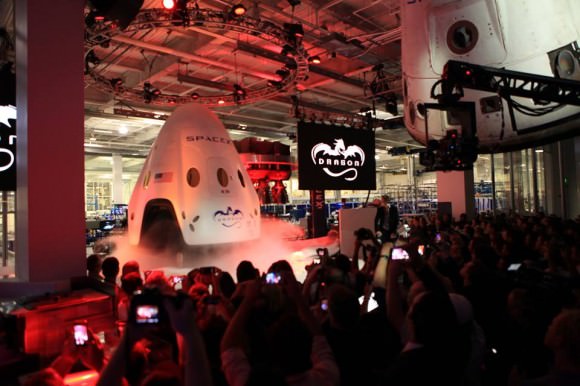


This is huge surprise from SpaceX, fascinating…
Landing anywhere propulsively is a curious notion. Why would you launch a huge mass of fuel just so you can later descend propulsively, rather than just descending on a parachute, which requires no fuel at all?
Or do they just mean cushion the last 10-20 metres of descent propulsively? (Not that there’s anything wrong with that).
Cost of fuel is unimportantly low, compared to landing the crew near the launch pad where it will be used again, rather than expensively employ the US Navy to fish it up from somewhere in the ocean.
The important thing is to land the hardware and its crew so that they can be reused (survivability is reusability, right?) AFAIK air resistance on the heat shield takes care of most of the slow down so little fuel is needed to do the helicopter precision landing. A bit like how the MSL Curiosity was landed by rockets firing already at high altitude in order to steer it to the targeted landing site. I think that parachutes will still be carried by the Dragon, but only as an emergency backup. Parachutes depend on weather and whatelse, rockets are more controlable.
Exactly. There seems to be a very pervasive idea, even among the space-literate, that fuel costs are the most significant part of a launch. The truth is, the fuel represents a really tiny fraction (<1%) of the cost of most launches.
From this link (http://www-pao.ksc.nasa.gov/kscpao/nasafact/pdf/ssp.pdf) you can see that the cost of fuel for the Shuttle in 2001 was $1.4 million. The cost of each launch was $450 million, although it's very hard to pin that number down. Some estimates have it at over a billion.
But either way, the fuel cost is basically a rounding error in the whole thing. It's amazing that this isn't more widely known.
Do you how much more the SRB’s added to the fuel cost, when you include the cost of solid propellant mix. This is not mentioned in the NASA document you linked to.
The chutes are used for emergencies.
– During descent, if the SuperDraco check fails, they will be deployed. This is clearly stated by Musk in the SpaceX video.
The remaining safely working SDs, if any, may be able to make a Soyuz type landing assist. [My speculation.] Or not, it may be up to the pilot to make such a tough decision.
– During LAS they will be used for the landing since the fuel won’t suffice and/or the emergency is difficult enough to sort out control latitude vs position et cetera.
The landing will then be in seawater. But then again if LAS has been used because the launcher exploded the craft may need extra check or be discontinued anyway.
It has nothing to do with costs, it has to do with mass. The fuel, the engines (including the ones for redundancy) and the turbopumps/pressurized vessels weigh way more than a parachute. And for every kilo that you bring “up” you need to forsee a few tons of fuel, and this leads to bigger rocket engines or less cargo.
Moreover in a parachute, almost nothing can fail once it’s open. The engines solution on the other hand is in another class of complexity, where countless things can fail/go wrong.
Nevertheless, i can’t wait to see the first powered landings of the Dragon. It may be more complex and dangerous, but it has also many other advantages (among them being the “awsomeness factor :))
The landing system is nothing more than the launch abort system (LAS). In order to be able to abort once the first stage has separated, the launch abort system has to be dragged all the way to orbit. Since they took all those little rockets and all that fuel up with them anyway, it seems like a shame to waste the LAS, doesn’t it?
In the event of a normal launch, when the LAS isn’t used, it will be re-purposed for a powered landing. If the LAS is used, or if there is an anomaly detected in the system, the the backup parachutes will be used instead.
I do recall that the Shuttle would also be very cheap and very reusable.
Lets wait and see how reusable SpaceX really is and the hidden costs that will popup.
Good question.
– A minor part of that fuel would be used for reentry burn anyway, it is now transferred from Draco supply to SuperDraco. (Actually I think all engines will share a redundant cross flow system.)
– Musk intends to make the entire launcher/craft combination, with the current exception of the trunk, reusable. He says so in the SpaceX video. To do that, he decided to retain the LAS engines.
That buys Dragon V2 several things.
— It will have, as opposed to all earlier crafts including the Shuttle, LAS capability through the entire ascent.
— It will save on reentry engines, the Dracos are now down to 12 (count them!) instead of 18 (IIRC).
— It will save on ground landing engines for reusability, by reusing the LAS engines.
Note that the ISS contenders CST-100 and DreamChaser has both the same retained pusher LAS designs. Note too that it may be that only DC goes for reusability, I’m not sure CST-100 has claimed it.
Is the design choice ideal? No. The engine capability is set by the LAS needs (high acceleration). The fuel volume is set by the landing needs (long burn), so the whole mass is present for the entire trip. Seems the hypergolic engine saves on throttle needs though, they seem to pulse it for weaker burn in the engine test video, somewhat ameliorating the compromise.
Given fuel use reusability, is it possible? Yes, the Buran showed that it makes sense for crafts. And the Falcon 9R is close to demonstrate the same for 1st stages.
And is it viable? As long as rapid reuse do not shrink the LEO mass from ~ 4 % below, say, 2 %, it may be so. Both SpaceX and Skylon puts their money into it.
Re chutes, no craft use them on land without engine assist. (E.g. Soyuz.) And land descent, no seawater immersion, is a must for rapid reuse.
I should also point out that land vs sea landings makes a whole world of difference in two other aspects.
– Sea landings cost a lot, must be thoroughly planned, et cetera.
Instead of an air corridor, there is also a water strip that must be barred from ships, assisted by expensive service ships, et cetera. I won’t say the expense is up there vs halving the LEO mass. But it should be kept in mind.
Especially savings for the 1st stage reuse, which will simply return in the same air corridor and with the same weather conditions a few minutes after launch.
– SpaceX target is Mars colonization, with scale making it economical. I.e. proposed ~ 80 000 colonists during a decade with 4-5 Earth-Mars-Earth transit windows, ~ 800 crafts @ 100 colonists, ~ 200 crafts/window, 2-4 crafts returning daily for a 3-6 months window.
SpaceX won’t have time and resources managing sea landings even if they would be possible vs reuse.
Very neat idea to use the PICA shield for the SuperDracos as well, but as seen on V1 the smaller Dracos won’t need it. I think the reveal was made possible by Falcon 9R showing that engines can be reliably restarted while hanging out in supersonic flows. If they hadn’t had that demo, the design would be preliminary pending test during max-Q LAS, which is later this year. Now its the final, flight capable when finished, hardware.
The Shuttle control engines were always used within the stationary flow behind the shock transition, so while that was somewhat telling about capability it wasn’t the full Monthy.
By the way, and it may be an artefact of the video which seems to be part of the old Dragon V1 video with an exchanged craft outline, but the Canadarm grappling target is still deployed.
Either the V2 is a transitive craft which can replace V1 for cargo immediately, or they intend to retain the berthing capability for backup indefinitely. (If that makes sense with the different ports used I do not know, but the Canadarm has potentially holdfasts at many of the current ISS ones.)
Perhaps the Canadarm handle is a backup to the primary docking maneuvering system.
On re-usability; seawater is terrible stuff to dunk a spacecraft in. It is the enemy of lightweight alloys and electronics. So land is the place to er, land.
The interior looks really science-fiction-y. I imagine that when they fly to the ISS, a lot of that empty space will be full of stores.
If it is only used for LEO then you can reduce the mass big time by having it a fully automated capsule manned. All it requires for redundancy would be stabilizing RCS fuel to prevent it from rolling uncontrollably and emergency life support for 2 days. A flash-light and a ebook reader so the stuck astronauts could have some R&R during the wait.
It would be interesting if they created a more controllable rescue capsule that can be launched just in case this one gets stranded in orbit.
I watched the presentation, broadcast about 10 minutes late. Did Space X do this to build up the excitement level? Probably simple showmanship? Bygones and not a problemo. It is just so good to see a ‘home-brewed’ rocket evolving. Minor delays are to be expected and are big thing because when it comes to spaceflight, it’s best to get it right the first time!
Donno if they are using turbopumps for the rockets? Instead, methinks for weight savings they are using pressurized Helium to inject the fuel into the combustion chamber. The use of newly developed lightweight composite tanks for storage is key. Correct me if I’m wrong, but that’s a HUGE weight savings over turbopumps and associated control systems…
Using a pressurized fuel system and not having turbopumps makes the engines very simple and reliable, plus they can be started quickly. These are necessary qualities for a crew-escape system, also for powered landings. It just does not scale for a big rocket. The Merlin engines in the Falcon rocket have turbopumps.